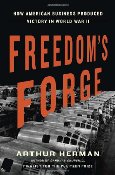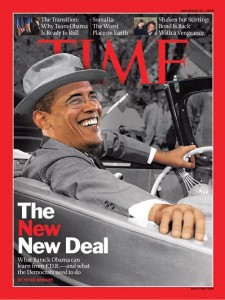
Freedom’s Forge—How American Business Produced Victory in World War II
“Leave nothing to the uncertainty of procuring a warlike apparatus at the moment of public danger.†George Washington Fifth Annual Message to Congress
 Freedom’s Forge by Arthur Herman is a celebration of people who know how to build things. The book is filled with characters that seemingly came from Ayn Rand’s novel Atlas Shrugged … except these Americans were not fictional. They were real industrialists and miracle makers. In 1939, the United States possessed only skeletal armed forces, ranking eighth in the world behind tiny Holland. Production plants in the United States had become obsolete or run down by depression and harmful tax policies. America was ill-prepared for war and did not have factories that could change the situation.  From this standing start, American industry by 1942 was producing more war materials than Germany, Japan, and Italy combined, and by the end of the war the United States had manufactured two-thirds of all war materials used by the Allies.
Freedom’s Forge by Arthur Herman is a celebration of people who know how to build things. The book is filled with characters that seemingly came from Ayn Rand’s novel Atlas Shrugged … except these Americans were not fictional. They were real industrialists and miracle makers. In 1939, the United States possessed only skeletal armed forces, ranking eighth in the world behind tiny Holland. Production plants in the United States had become obsolete or run down by depression and harmful tax policies. America was ill-prepared for war and did not have factories that could change the situation.  From this standing start, American industry by 1942 was producing more war materials than Germany, Japan, and Italy combined, and by the end of the war the United States had manufactured two-thirds of all war materials used by the Allies.
 The thesis of Freedom’s Forge is that this unbelievable accomplishment was made possible by Roosevelt removing the shackles from the American capitalist system. Roosevelt was reluctant to go against the advice of most of his New Dealers, but on May 28, 1940 he telephoned William Knudsen, President of General Motors, and asked for help. Actually, Roosevelt had been toning down his anti-business rhetoric since he won the 1938 election. This did not sit well with his wife or many in his cabinet. Most believed winning the war required using the central government planning model that had worked so well for the Axis Powers.
The thesis of Freedom’s Forge is that this unbelievable accomplishment was made possible by Roosevelt removing the shackles from the American capitalist system. Roosevelt was reluctant to go against the advice of most of his New Dealers, but on May 28, 1940 he telephoned William Knudsen, President of General Motors, and asked for help. Actually, Roosevelt had been toning down his anti-business rhetoric since he won the 1938 election. This did not sit well with his wife or many in his cabinet. Most believed winning the war required using the central government planning model that had worked so well for the Axis Powers.
Herman gives Roosevelt credit for seeing the world situation realistically and changing how he dealt with businessmen.
President Roosevelt had built his career on the conviction that government knew best, and on vilifying American business and businessmen, whom he had blamed for the Great Depression. “I welcome their hatred,†he told a campaign audience in 1936, and American business had paid him back with interest.
A couple of examples illustrate Roosevelt’s initial attitude about defense industries.
Roosevelt had also encouraged Senator Gerald Nye (a Republican) and his young legal counsel Alger Hiss in their sensational investigations into the conduct of American armaments manufacturers in the First World War. The Nye Committee blasted companies like DuPont, General Electric, General Motors, Colt Arms, Electric Boat (makers of submarines), Curtiss, Boeing, and Sperry Gyroscope as “merchants of death.†It even blamed their “lies, deceit, hypocrisy, greed, and graft†for getting the United States into the war in the first place.
DuPont got the message. The Wilmington, Delaware, firm had supplied America’s armed forces with gunpowder since the American Revolution. Now it slashed its munitions-making division to less than 2 percent of operations. Other companies drew the same lesson: Supplying America with arms was business you did not want.
Herman also pointed out that the aerospace industry had been relentlessly attacked by “stripping away their airmail contracts to divesting them of their civilian airline routes, and the so-called big breakup of 1934.â€
In the early stages of the war, New Dealers continued to side with unions against business.
During the punishing United Auto Workers strike, he had had Labor Secretary Frances Perkins calling him up in the middle of the night screaming that he was a scoundrel and a skunk for not giving in to the union’s demands. “You don’t deserve to be counted among decent men,†she had ranted. “You’ll go to hell when you die.â€
New Dealers believed the working man was the crucial cog in manufacturing, not management.
Interior Secretary Harold Ickes denounced the idea of giving business a major role in organizing for war, calling it an affront to democracy itself … Ickes worried that Knudsen and his friends would use the rearmament program to get big business’s nose “under the Administration tent,†as Ickes put it, at the expense of labor
Still, Roosevelt knew there had to be a change. Herman writes that if “Britain lost the war, it might mean that Germany would seize the Royal Navy, the single greatest armed force in the world.â€Â Nazis would rule the world. It was time for New Dealers to hold their nose and call upon industrialists to help save the nation and the world.
Knudsen believed he and his colleagues could do it. “Industry in the United States does more for the country in direct, or indirect, contributions to the public wealth than in any other country on earth,†he had told an audience in Detroit three years earlier. “And it will continue to do so if given the opportunity without restrictions.â€
Herman believes the lesson we should learn is that government antagonism toward business is not good for the economy or employment. On the other hand, if a strong President sets goals on what he wants to achieve, and then gets out of the way, nothing can beat a capitalist economy.
It was the most powerful and flexible system of wartime production ever devised, because in the end no one devised it. It grew out of the underlying productivity of the American economy, dampened by a decade of depression but ready to spring to life. Out of what seemed like chaos and disorder to Washington would come an explosion of innovation, adaptation, and creativity— not to mention hard work— across the country.
I found Freedom’s Forge engaging. I started my career at North American Aviation in defense manufacturing. Although considered ol’ timers by then, I had the pleasure of meeting and being taught by many of these men that Herman writes about. They were remarkable for their can-do attitude. There was a quote by Dutch Kindelberger who founded North American that epitomized the philosophy of these WWII industrialists: “Any idiot can design an airplane, but it takes a genius to design an airplane any idiot can build.â€Â This was from the designer of the P-51, renown as the best propeller-driven fighter of all time. If you lived with these men, you knew this quote was not meant to be disrespectful to labor. It was a message to designers and engineers that manufacturing was as much art as science and mass production depended on simplicity.
Today we hear a lot of laments that manufacturing is no longer a strength of the United States. This is ridiculous. John F. Kennedy called on this same breed of people to take us to the moon and they delivered. They’re still with us. All we need is good leadership with a clear vision for the nation.
Freedom’s Forge is a good read for those who study World War II, love manufacturing, or want some clues as to why we seem stuck in a stagnant economy today.
There are similarities between Presidents Roosevelt and Obama. There are big differences, as well. When push came to shove, Roosevelt didn’t let ideology get in the way of what needed to be done. Roosevelt also knew how to keep straight who were our friends and who were our enemies.
James D. Best is the author of the Steve Dancy Tales and Tempest at Dawn, a novel about the 1787 Constitutional Convention. Look for his new book, Principled Action, Lessons from the Origins of the American Republic.
 The posts are coming!
The posts are coming!


0 comments
Kick things off by filling out the form below.
Leave a Comment